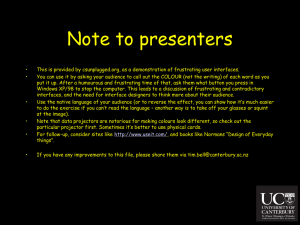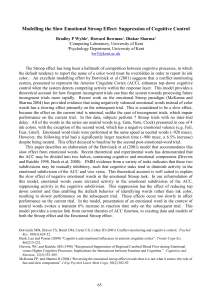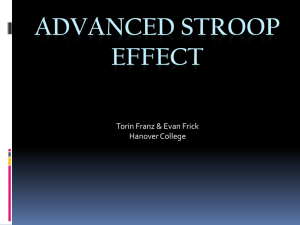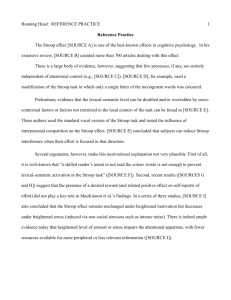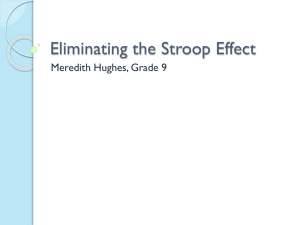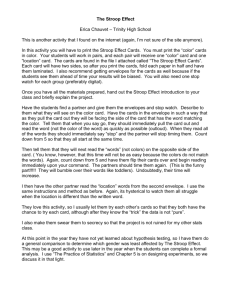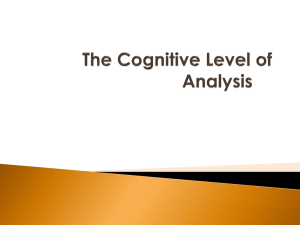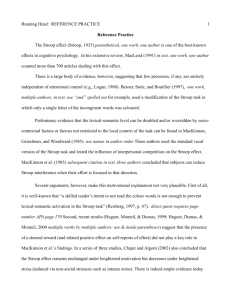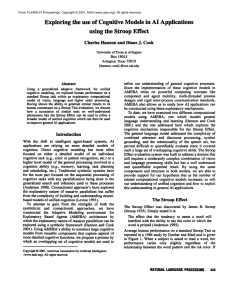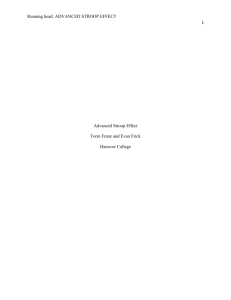Appendix - Springer Static Content Server
advertisement
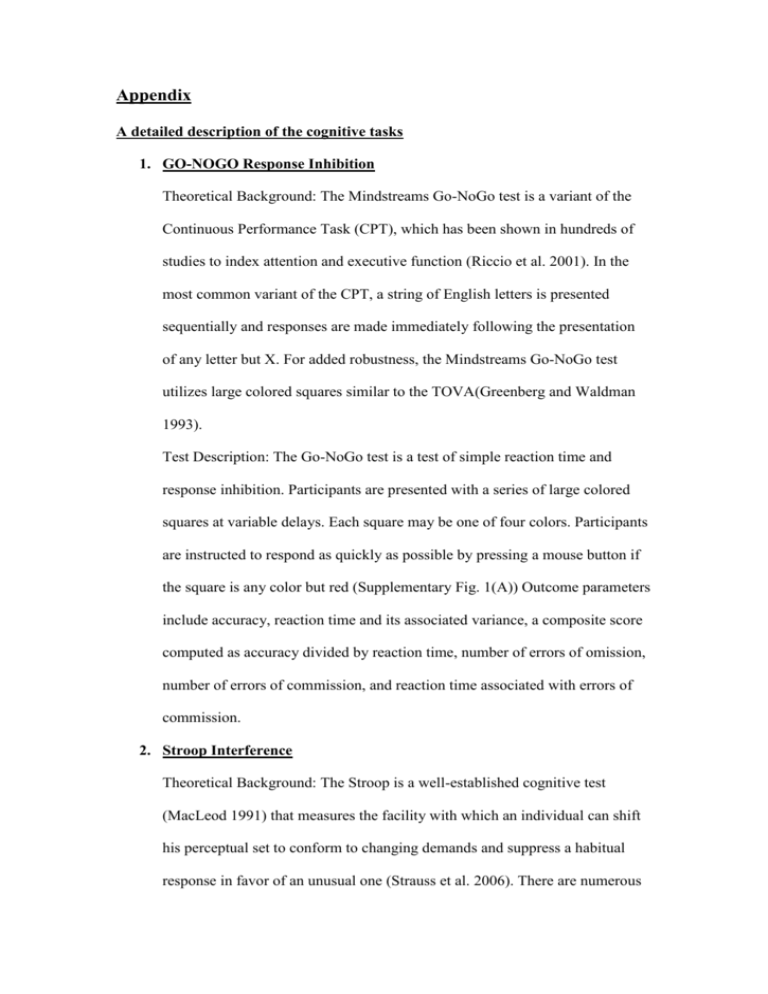
Appendix A detailed description of the cognitive tasks 1. GO-NOGO Response Inhibition Theoretical Background: The Mindstreams Go-NoGo test is a variant of the Continuous Performance Task (CPT), which has been shown in hundreds of studies to index attention and executive function (Riccio et al. 2001). In the most common variant of the CPT, a string of English letters is presented sequentially and responses are made immediately following the presentation of any letter but X. For added robustness, the Mindstreams Go-NoGo test utilizes large colored squares similar to the TOVA(Greenberg and Waldman 1993). Test Description: The Go-NoGo test is a test of simple reaction time and response inhibition. Participants are presented with a series of large colored squares at variable delays. Each square may be one of four colors. Participants are instructed to respond as quickly as possible by pressing a mouse button if the square is any color but red (Supplementary Fig. 1(A)) Outcome parameters include accuracy, reaction time and its associated variance, a composite score computed as accuracy divided by reaction time, number of errors of omission, number of errors of commission, and reaction time associated with errors of commission. 2. Stroop Interference Theoretical Background: The Stroop is a well-established cognitive test (MacLeod 1991) that measures the facility with which an individual can shift his perceptual set to conform to changing demands and suppress a habitual response in favor of an unusual one (Strauss et al. 2006). There are numerous versions of the Stroop Test, dating back to the original developed by Stroop himself in 1935. The key comparison is between a condition in which responses are habitual (e.g., indicate the color of the letters) and a condition in which responses are unusual (i.e., indicate the color of the letters despite the fact that they spell a different color-word). The Stroop test has been shown to discriminate among brain-damaged individuals, those with schizophrenia, Parkinson’s disease, and Huntington’s disease (Hanes et al. 1996). Perrett (Perret 1974) and Stuss et al. (Stuss et al. 2001) have reported that the Stoop interference effect is greater for patients with frontal lobe damage than for other groups, supporting the notion that the Stroop interference effect indexes executive function. Importantly, the Stroop test has also been shown to index severity of dementia (Koss et al. 1984). Test Description: Like the Go-NoGo test, the Stroop test measures simple reaction time and response inhibition. The Mindstreams Stroop test consists of three phases. Outcome parameters for each phase include accuracy, reaction time and its associated variance, and a composite score computed as accuracy divided by reaction time. In Phase I, participants are presented with a word in colored letters, with the stipulation that the word does not name a color. Following a brief delay, participants are presented with a pair of colored squares, one on the left and the other on the right. They are instructed to choose as quickly as possible which of the two squares is the same color as the letters of the word presented immediately prior (e.g., blue) by pressing either the left or right mouse button, depending upon which of the two squares is the correct color. For Phase II, participants are presented with a word that names a color in noncolored letters. As in Phase I, participants are then presented with a pair of colored squares and must choose as quickly as possible which square is the color named by the color word presented immediately prior. In Phase III, participants are presented with a word that names a color in letters of a color other than that named by the word. As in Phase I, participants must choose as quickly as possible which of two squares the same color as the letters of the word is presented immediately prior (Supplementary Fig. 1(B)). The conflicting information provided by the meaning of the word and the color of its letters lead to a decrement in performance relative to the other phases where there is no conflict. This reduced performance is termed the “Stroop” interference effect and is a classical finding in cognitive psychology. 3. Non-verbal memory Theoretical background: This task is based on the paper-and pencil Benton Visual Retention Test (BVRT) (Benton 1955) and Brief Visuospatial Memory Test (BVMT) (Benedict et al. 1996). It is assumed that the task relies upon retrieval of encoded visual items. Test description: Participants are presented with eight black-and-white drawn pictures of simple common objects or shapes, arranged in two rows of four pictures each, presented centrally for 20 seconds on a black background. The subjects are instructed to remember their orientation. This study phase is followed by an immediate recognition test consisting of 8 trials (one per picture). On each recognition trial, four versions of a picture are presented, each pointing in a different direction (Supplementary Fig. 1(C)). The subject's task is to use the number pad on the keyboard to identify the version presented during the study phase (maximum time to respond: 30 seconds). This studytest sequence repeats up to three more times (depending upon performance) with the same stimuli shown in the first repetition. In each repetition the stimuli are located differently on the screen and in each repetition the order of the recognition trials is changed to avoid location and order biases (Dwolatzky et al. 2003). As with the Verbal Memory test, four consecutive study/test repetitions follow immediately, and an additional recognition test is administered following a delay of approximately 10 minutes with two other Mindstreams tests intervening. Accuracy is calculated as the percent of correct responses, RT is calculated as average response time (in milliseconds) for correct responses. If a subject achieves perfect accuracy (i.e., 100%) on a given repetition, the test terminates, and the scores (accuracy and RT) for that repetition are duplicated for any remaining repetitions. 4. Verbal Memory Theoretical background: The formation of new associations between items is critical for establishing episodic memories. Yet elderly individuals who suffer from cognitive decline have trouble forming these new associations (Fowler et al. 2002). The Mindstreams verbal memory test, inspired by the Logical Memory test of the Wechsler Memory Scale, 3rd Edition (WMS-III), is designed to detect such impairment. Strength of association is varied among word pairs presented at study and foils presented at test to yield the appropriate range of performance to distinguish among healthy elderly and those with cognitive impairment (Nelson et al. 2001). Test Description: The Verbal Memory test measures immediate and delayed recognition memory for verbal paired associates. Participants are presented with 10 pairs of words to study followed by a recognition test in which they are presented with one member of a previously presented pair together with four possible alternatives for the other member of the pair (Supplementary Fig. 1(D)). Responses are made using the keyboard number pad to indicate which pair was previously presented. Four consecutive study/test repetitions follow immediately, and an additional recognition test is administered following two other Mindstreams tests for delay period of approximately 10 minutes. Outcome parameters2 include accuracy four each of the four immediate recognition tests, total accuracy across these repetitions, and accuracy for the delayed recognition test. Slope of learning across repetitions is also computed 5. Staged Information Processing Speed Theoretical Framework: Arithmetic ability has been shown to correlate more highly with other neuropsychological predictors of Alzheimer’s disease than even the standard MMSE (Rosselli et al. 1998). The Mindstreams test of Staged Information Processing Speed utilizes simple arithmetic, equally taxing across a range of educational levels, to reveal differences in performance as a function of stimulus presentation rate. The test is designed to exploit the advantages of computer-based testing to accurately assess information processing speed. Its multilevel, timed format is fashioned to incrementally tax cognitive resources, providing a precise indicator of extent of impairment. Test Description: The Staged Information Processing Speed test measures information processing at increasing levels of complexity. The test is comprised of three levels of information processing load: single digits, two- digit arithmetic problems (e.g., 5-1), and three-digit arithmetic problems (e.g., 3+2-1). For each of these three levels, stimuli are presented at three different rates, incrementally increasing as testing continues. Participants are presented with a series of digits or arithmetic problems (as per the level) and are instructed to respond as quickly as possible by pressing the left mouse button if the digit or result is less than or equal to 4 and the right mouse button if it is greater than (Supplementary Fig. 1(E)). Outcome parameters for each rate increment for each level include accuracy, reaction time and its associated variance, and a composite score computed as accuracy divided by reaction time. References Benedict RHB, Schretlen D, Groninger L, Dobraski M, Shpritz B (1996) Revision of the brief visuospatial memory test: Studies of normal performance, reliability, and validity. Psychol Assessment 8 (2):145-153 Benton AL (1955) The revised visual retention test: Clinical and experimental applications. State University of Iowa; distributor for the U.S.A., Psychological Corp., New York, Iowa City, Dwolatzky T, Whitehead V, Doniger GM, Simon ES, Schweiger A, Jaffe D, Chertkow H (2003) Validity of a novel computerized cognitive battery for mild cognitive impairment. BMC Geriatr 3:4 Fowler KS, Saling MM, Conway EL, Semple JM, Louis WJ (2002) Paired associate performance in the early detection of dat. J Int Neuropsychol Soc 8 (1):58-71 Greenberg LM, Waldman ID (1993) Developmental normative data on the test of variables of attention (t.O.V.A.). J Child Psychol Psychiatry 34 (6):1019-1030 Hanes KR, Andrewes DG, Smith DJ, Pantelis C (1996) A brief assessment of executive control dysfunction: Discriminant validity and homogeneity of planning, set shift, and fluency measures. Arch Clin Neuropsychol 11 (3):185191 Koss E, Ober BA, Delis DC, Friedland RP (1984) The stroop color-word test: Indicator of dementia severity. Int J Neurosci 24 (1):53-61 MacLeod CM (1991) Half a century of research on the stroop effect: An integrative review. Psychol Bull 109 (2):163-203 Nelson DL, Zhang N, McKinney VM (2001) The ties that bind what is known to the recognition of what is new. J Exp Psychol Learn Mem Cogn 27 (5):1147-1159 Perret E (1974) The left frontal lobe of man and the suppression of habitual responses in verbal categorical behaviour. Neuropsychologia 12 (3):323-330 Riccio CA, Waldrop JJ, Reynolds CR, Lowe P (2001) Effects of stimulants on the continuous performance test (cpt): Implications for cpt use and interpretation. J Neuropsychiatry Clin Neurosci 13 (3):326-335 Rosselli M, Ardila A, Arvizu L, Kretzmer T, Standish V, Liebermann J (1998) Arithmetical abilities in alzheimer disease. Int J Neurosci 96 (3-4):141-148 Strauss E, Sherman EMS, Spreen O, Spreen O (2006) A compendium of neuropsychological tests : Administration, norms, and commentary. 3rd edn. Oxford University Press, Oxford ; New York Stuss DT, Floden D, Alexander MP, Levine B, Katz D (2001) Stroop performance in focal lesion patients: Dissociation of processes and frontal lobe lesion location. Neuropsychologia 39 (8):771-786 Figure 1, Appendix. An illustration of the tests performed in the present study. (A) An illustration of the GO-NOGO Response Inhibition: Participants are presented with a series of large colored squares at variable delays. Each square may be one of four colors. Participants are instructed to respond as quickly as possible by pressing a mouse button if the square is any color but red. (B) An illustration of the Stroop interference test: In phase I, no interference – the participatnts are requested to respond to the color of the letters (e.g., green). The word does not name a color. In phase II, no interference - participants are requested to respond to the meaning of the word (e.g., red). The word names a color in non-colored letters. In phase III – interference - participants are requested to repond to the color of the letters. The word names a color (e.g., red in letters of a color other than that named by the word (e.g., green). (C) Illustration of the non-verbal memory test - participants are presented with eight black-and-white drawn pictures of simple common objects or shapes, and are instructed to remember their orientations, followed by a recognition test. (D) Illustration of the verbal memory test – Participants are presented with 10 pairs of words to study followed by a recognition test. (E) Illustration of the staged information processing speed test - Participants are presented with a series of digits or arithmetic problems (e.g., 8-2) and are instructed to respond as quickly as possible by pressing the left mouse button if the digit or result is less than or equal to 4 and the right mouse button if it is greater than 4.
